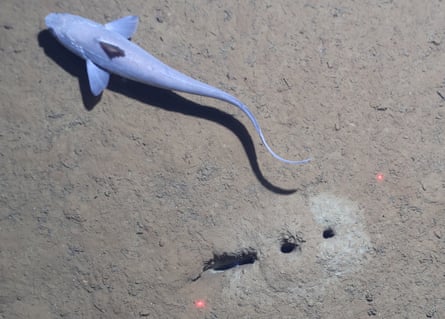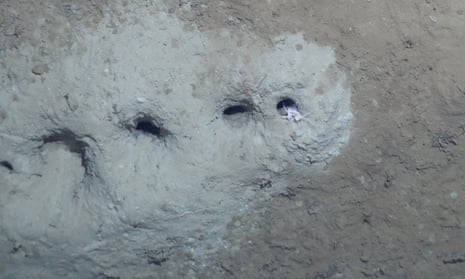During an expedition in the cold waters of the Bering Sea, between Russia and Alaska, last summer, a team of scientists spotted neat lines of holes poked into the seafloor. But they did not know who – or what – had created them.
Scientists on the German research vessel Sonne set about hunting for clues. They sifted through several hundred images captured by a camera towed above the seafloor.
The pictures revealed distinctive rows oval-shaped holes, each measuring roughly two or three centimetres – as if something had pogo-sticked a short way over the seabed. But the mystery remained – until now.
The discovery happened by chance. Various animals were spied nearby and became suspects. “Most things were pretty easy to exclude,” says Julia Sigwart from the Senckenberg Research Institute and Natural History Museum in Frankfurt. The holes were too small for sea urchins to fit into, and the wrong shape to be worm burrows.
Then one of the team, Angelika Brandt, also from the Senckenberg Museum, noticed something: a little crustacean.
“Angelika jumps up, she points at the screen and says: ‘It’s that! That’s the maker!’ and then she ran out of the room,” says Sigwart.
A few moments later, Brandt returned with an external computer hard drive and showed everyone a video that had been shot 40 years earlier by a colleague. It was an amphipod – a relative of beach-dwelling sand hoppers – from Antarctica, filmed in captivity busily digging a burrow in the sand in its aquarium. Using its huge front appendages, it was carefully shovelling sand out of a hole and heaping it in a neat pile without letting it slide back in.

The Antarctic amphipod looked a lot like the one Brandt spotted in the Bering Sea. “When I saw the animal sitting in that hole, it was really a deja vu moment,” she says.
The Bering Sea amphipods have yet to be caught making the holes, but Brandt and colleagues think they are probably eating sediment in nutrient-rich layers of the seabed, and digging tunnels as they go.
If they are anything like their Antarctic cousins, these 2cm-long crustaceans could also be using the burrows to breed. Female amphipods have pouches in which they raise their young. After they are born, the larvae don’t float away like the offspring of many sea creatures do, but can stay in their parents’ burrows for weeks or even months.
after newsletter promotion
“Having a burrow is a way to access food, get protection from potential predators and it’s a safe place to raise your kids,” says Sigwart.
The burrows matter not just for the amphipods themselves, but also because they create niches for other species and are probably important for biodiversity on abyssal plains. “Most animals in the deep sea are very small – maybe a millimetre in size,” says Sigwart. At that scale, a 30cm-long burrow is a mountain. “If you’re tiny, then even small changes in topography would have a massive impact on your habitat and how you interact with your environment,” she says.
The discovery has given scientists hope that they might make progress deciphering the many other mysterious marks in the mud at the bottom of the ocean. “It’s amazing how much activity there is in and on the seafloor. It’s just full of traces and holes,” says Sigwart.
